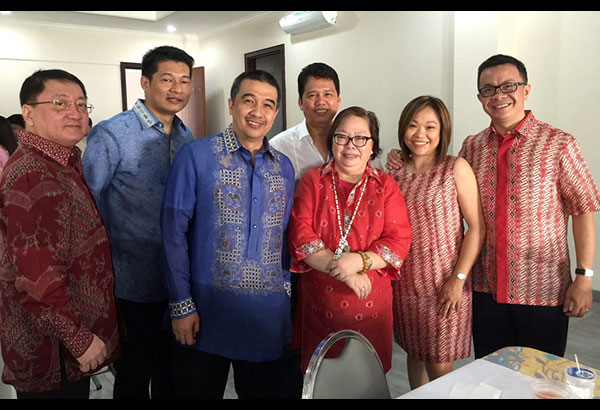Barong or Batik ? It’s both!

Freddy and Thelma (center) with Filipino expats in Jakarta, proudly sporting the Barong Batik.
MANILA, Philippines - An innovation that combines the traditional wear of two countries may just become the official ASEAN attire.
At one DSWD monitoring meeting about two years ago, Muslim woman leader Amina Rasul showed us some fabrics and tops which came from a friend of hers from Jakarta. I immediately chose a top for an ASEAN meeting I was attending. I did not get to meet the people behind the product until a year later. Freddy Mercado Jr., the creator and designer, and his business partner Thelma Victorio would visit me with more blouses in tow.
The two moved to Jakarta in the 1980s as executives – Freddy in 1988 to work with Indovision, the first direct broadcast satellite company, and Thelma in 1989 to work as an investment officer with RCTI, the first commercial television station.
The idea for what would become a fusion fashion sensation came in 2005 when Freddy brought a piece of jusi to an old lady doing batik. It took about three years for them to get the process right.
“We are proud to use our jusi,” Thelma tells me at our first meeting. “But we are also proud that we can design something that integrates the best of ASEAN – batik done on jusi – which is why we call it Barong Batik.”
Freddy and Thelma never thought the demand for this special fusion fashion would take off from when he first wore one to a Philippine Independence Day reception in Jakarta. Now, especially with people having ASEAN in their consciousness, this collaboration between countries is even more meaningful.
It starts with the best jusi (banana fiber) – the smoothness of silk in a woven fabric which is cool and light and perfect for our tropical weather. The jusi comes in its natural beige color. Thelma says over 100 housewives in Laguna work on over 100 cuts of jusi cloth a month to meet their requirements.
The Philippine jusi material is then brought to Pekalongan in Central Java, where about 200 artisans led by Romy Oktabirawa, a fourth generation batik artisan, using traditional methods, translate designs created by Freddy onto the fabric.
There are two kinds of batik methods – Batik Cap (pronounced chap) wherein copper stamps are used to “print” patterns of hot wax on to fabric, and Batik Tulis, referring to the sharp pointed instrument called the cjanting that is used just like a pen, but carrying hot wax instead of ink. Batik Tulis is more intricate as each line or figure is completely hand drawn, and details can show variations in size and shape. This makes each and every Batik Tulis design unique, and one of a kind – a piece of artwork you can wear!
After the wax design has been printed or drawn, the material is dipped into dye and then dried. This process is repeated several times until the desired color is achieved. Once the material reaches the color desired, it is then dipped into boiling water to remove the wax, beautifully exposing the design of the batik.
For the Batik Cap process, each piece of material will take three to four weeks to complete, while it takes seven to eight weeks to process the Batik Tulis.
While Freddy thinks up the batik designs and the cut for ready-to-wear outfits, Thelma is at the forefront taking care of the finance and marketing aspect of the business, among other businesses where she is a financial advisor. Together they weave beautiful fabrics, which can also be bought as Barong Batik material and sewn as you wish.
As we celebrate ASEAN at 50 this year, it is timely for the duo behind Barong Batik to bring their creations to more accessible places. So next month, Barong Batik will be joining the Great Women Trade Showcase at the week-long ASEAN Women Business Conference at the PICC on Aug. 28-31.
Barong Batik will also be featured at the ArteFino craft fair on Aug. 25-27 at 8 Rockwell.
It is not every day that one finds a creative fusion of traditional artistry that proudly embodies the heritage of two countries into a classic wear.
Barong Batik looks like it’s here to stay.
It may as well be the ASEAN barong or baro (a Malay word meaning dress which the Philippines shares with Malaysia and Indonesia) – a truly unique fusion in Asian fashion.
- Latest
- Trending




















